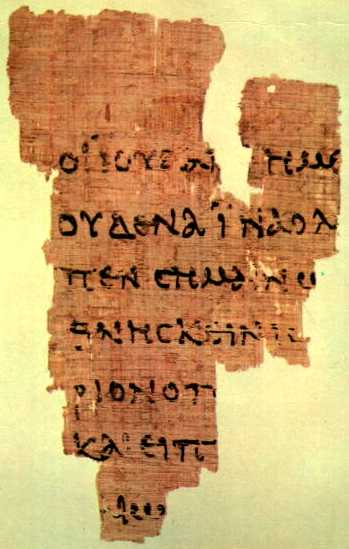






|
|
of the New Testament. This photo is of the recto (front side). ©Copyright John Rylands Library of Manchester. |
| DESCRIPTION |
|
|---|---|
| Language: | Greek |
| Medium: | papyrus |
| Size: | 3.5 inches long 2.5 inches wide |
| Length: | 7 lines on each side |
| Approximate Date: | c. 125–150 CE |
| Place of Discovery: | Egypt |
| Date of Discovery/ Acquisition: |
1920 |
| Acquirer: | Bernard P. Grenfell |
| Current Location: | John Rylands Library Manchester, England |
| Inventory Number: | Rylands Greek Papyrus 457 |
| Manuscript Number: | P52 |
| Manuscript Family: | Alexandrian |
| GREEK TEXT Recto: John 18:31-33 (Readable as Greek if "SYMBOL" font is installed) |
by K. C. Hanson |
| EIPEN
OUN AUTOIS O PILATOS LABETE AUTON UMEIS KAI KATA TON NOMON UMWN KRINATE AUTON
EIPON AUTW OI IOUDAIOI
HMIN OUK EXESTIN APOKTEINAI OUDENA INA O
LOGOS TOU IHSOU PLHRWQH ON EIPEN SHMAINWN POIW
QANATW HMELLEN APOQNHSKEIN EISHLQEN OUN PALIN
EIS TO PRAITWRION O PILATOS KAI EFWNHSEN TON
IHSOUN KAI EIPEN AUTW SU EI O BASILEUS TWN
IOUDAIWN
Letters in red are visible on the fragment; letters in black are reconstructed |
Therefore Pilate said to them, "Take him yourselves and judge him by your own law." The Judeans said to him, "It is not lawful for us to put anyone to death." This was to fulfill the word which Jesus had spoken to show by what death he would die. Pilate entered the praetorium again and called Jesus, and said to him, "Are you the king of the Judeans?" |
| GREEK TEXT Verso: John 18:37-38 |
TRANSLATION by K. C. Hanson |
| EIPEN
OUN AUTW O PILATOS OUKOUN BASILEUS EI SU APEKRIQH O IHSOUS SU LEGEIS OTI BASILEUS
EIMI EGW EIS TOUTO GEGENNHMAI KAI EIS TOUTO
ELHLUQA EIS TON KOSMON INA MARTURHSW TH ALHQEIA
PAS O WN EK THS ALHQEIAS AKOUEI MOU THS FWNHS
LEGEI AUTW O PILATOS TI ESTIN ALHQEIA
KAI TOUTO EIPWN PALIN EXHLQEN PROS TOUS
IOUDAIOUS KAI LEGEI AUTOIS EGW OUDEMIAN EURISKW EN
AUTW AITIAN
Letters in red are visible on the fragment; letters in black are reconstructed |
Therefore Pilate said to him, "Then you are a king?" Jesus answered, "You say that I am a king. For this I was born, and for this I have come into society: to witness to the truth. Everyone who belongs to the truth hears my voice." Pilate said to him, "What is truth?" After he had said this, he went out to the Judeans again, and he told them, "I find no crime in him." |
| DISCUSSION QUESTIONS |
|
1. How does the discovery of this fragment of John affect the dating of the gospel? What had New Testament scholars argued before this fragments was discovered? 2. Metzger and others have identified this fragment with the "Alexandrian" family of manuscripts. What is a textual "family" and how does that help interpret manuscripts? What problems have been raised about this construct? 3. By what means do scholars date manuscripts and fragments of manuscripts? 4. What factors account for so many biblical papyri having been discovered in Egypt? |

| SELECT BIBLIOGRAPHY |
|
Aland, Kurt. "The Significance of the Papyri for Progress in New Testament Research." In The Bible in Modern Scholarship: Papers Read at the 100th Meeting of the SBL, December 28-30, 1964, edited by J. P. Hyatt, 325-46. Nashville: Abingdon, 1965. Aland, Kurt. "Neue neutestamentliche Papyri." New Testament Studies 3 (1957) 261-86. Aland, Kurt and Barbara Aland. The Text of the New Testament: An Introduction to the Critical Editions and to the Theory and Practice of Modern Textual Criticism. Translated by E. R. Rhodes. Grand Rapids: Eerdmans; Leiden: Brill, 1987. Deissmann, Adolf. "Ein Evangelienblatt aus den Tagen Hadrians." Deutsche allgemeine Zeitung 564 (December 3, 1935). [English trans. in British Weekly December 12, 1935.] Epp, Eldon J. "Textual Criticism." In The New Testament and Its Modern Interpreters, edited by E. J. Epp and G. W. MacRae, 75-126. The Bible and Its Modern Interpreters. Philadelphia: Fortress Press, 1989. Fee, Gordon D. "P75, P66 , and Origen: The Myth of Early Textual Recension in Alexandria." In New Dimensions in New Testament Study, edited by R. N. Longenecker and M. C. Tenney, 19-45. Grand Rapids: Zondervan, 1974. Metzger, Bruce M. The Text of the New Testament: Its Transmission, Corruption and Restoration. 2nd ed. New York: Oxford Univ. Press, 1968. Roberts, Colin H. An Unpublished Fragment of the Fourth Gospel in the John Rylands Library. Manchester, 1935 [pamphlet; reprinted in Bulletin of the John Rylands Library 20 (1936):1-3.] Roberts, Colin H. and others. Catalogue of the Greek and Latin Papyri in the John Rylands Library, vol. 3, pp. 1-3. Manchester, 1938. Roberts, Colin H. Greek Literary Hands 350 B.C.—A.D. 400. Oxford: Clarendon, 1956. Salmon, Victor. The Fourth Gospel: A History of the Textual Tradition of the Original Greek Gospel. Translated by M. J. O'Connell. Collegeville, Minn.: Liturgical, 1976 [French ed. 1969]. |
 Return to Palestine in the Time of Jesus
Return to Palestine in the Time of Jesus Return to K. C. Hanson's Collection of Greek Documents
Return to K. C. Hanson's Collection of Greek Documents  Return to K. C. Hanson's HomePage
Return to K. C. Hanson's HomePage